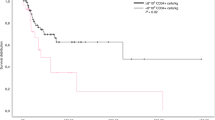Abstract
The purpose of this study was to determine the safety and efficacy of filgrastim as an adjunct to induction and consolidation chemotherapy in poor risk patients with myelodysplastic syndrome (MDS). Filgrastim was given both during and after chemotherapy with the objective to accelerate hematopoietic repopulation and enhance the efficacy of chemotherapy. In a prospective randomized multicentre phase II trial, a total of 64 patients with poor risk primary MDS were randomized to receive either granulocyte colony-stimulating factor (G-CSF, filgrastim, AMGEN, Breda, The Netherlands) 5 μg/kg/day subcutaneously or no G-CSF in addition to daunomycin (30 mg/m2/days 1, 2 and 3 intravenous bolus) and cytarabine (200 mg/m2 days 1–7, continuous infusion). The overall complete response rate was 63%: 73% for patients receiving filgrastim as compared to 52% in the standard arm (P = 0.08). Overall survival at 2 years was estimated at 29% for patients assigned to the filgrastim arm and 16% for control patients (P = 0.22). The median time for recovery of granulocytes towards 1.0 × 109/l post-chemotherapy was 23 days in the filgrastim-treated patients vs 35 days in the standard arm (P = 0.015). There were no differences in time of platelet recovery, length of hospital stay, duration of antibiotic use or infectious complications between the two treatment groups. However the earlier recovery of neutrophils in the filgrastim group was associated with a reduced interval of 9 days between the induction and consolidation cycle. In patients with poor risk MDS the use of filgrastim during and after induction therapy results in a significantly reduced neutrophil recovery time. Further study may be warranted to see if the apparent trend of the improved response to chemotherapy in combination with filgrastim can be confirmed in greater number of patients and to assess the effect of the addition of filgrastim on survival.
This is a preview of subscription content, access via your institution
Access options
Subscribe to this journal
Receive 12 print issues and online access
$259.00 per year
only $21.58 per issue
Buy this article
- Purchase on Springer Link
- Instant access to full article PDF
Prices may be subject to local taxes which are calculated during checkout
Similar content being viewed by others
Author information
Authors and Affiliations
Consortia
Rights and permissions
About this article
Cite this article
Ossenkoppele, G., van der Holt, B., Verhoef, G. et al. A randomized study of granulocyte colony-stimulating factor applied during and after chemotherapy in patients with poor risk myelodysplastic syndromes: a report from the HOVON Cooperative Group. Leukemia 13, 1207–1213 (1999). https://doi.org/10.1038/sj.leu.2401478
Received:
Accepted:
Published:
Issue Date:
DOI: https://doi.org/10.1038/sj.leu.2401478
Keywords
This article is cited by
-
Treatment with G-CSF reduces acute myeloid leukemia blast viability in the presence of bone marrow stroma
Cancer Cell International (2015)
-
Colony-stimulating factors in the management of neutropenia and its complications
Annals of Hematology (2005)
-
No benefit from adding GM-CSF to induction chemotherapy in transforming myelodysplastic syndromes: better outcome in patients with less proliferative disease
Leukemia (2003)
-
Granulocyte–macrophage colony-stimulating factor (GM-CSF) priming with successive concomitant low-dose Ara-C for elderly patients with secondary/refractory acute myeloid leukemia or advanced myelodysplastic syndrome
Leukemia (2002)



